(Written by Julio Preuss)
Earlier this month I participated in Brickfête, a LEGO convention in Toronto, where I displayed one of my recently finished models (well, it’s never really finished, but at least it was presentable enough). A replica of the Canadian Broadcasting Center (CBC), the model ended up winning the Best of Brickfête Toronto Award. So, I thought to share a little bit about the building and my LEGO version of it. 🙂
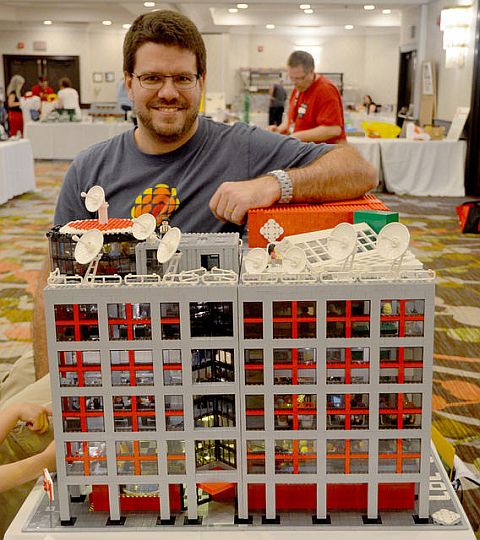
The Canadian Broadcasting Center is the broadcast headquarters and master control point for the Canadian Broadcasting Corporation’s English-language television and radio services. It also contains studios for local and regional French language productions, and is the home to the North American Broadcasters Association as well (photo from Wikipedia).
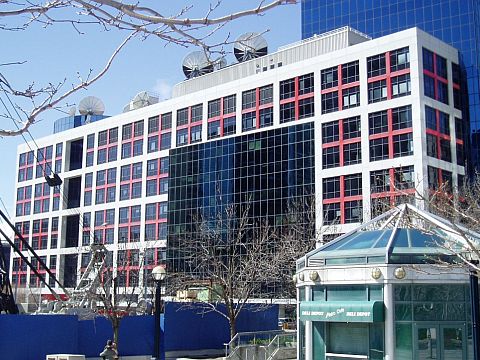
I’m a product manager on CBC’s Digital Operation team, and every day as I have been walking towards the southeast corner of the building, I kept thinking that it had such a LEGO-ish look. I love LEGO, and I love CBC, so it made perfect sense to recreate the building in LEGO.
It took me around six months to design and build the model. I started with some digital sketches back in January, then began gathering the necessary LEGO pieces. I built mostly in the evenings and weekends.
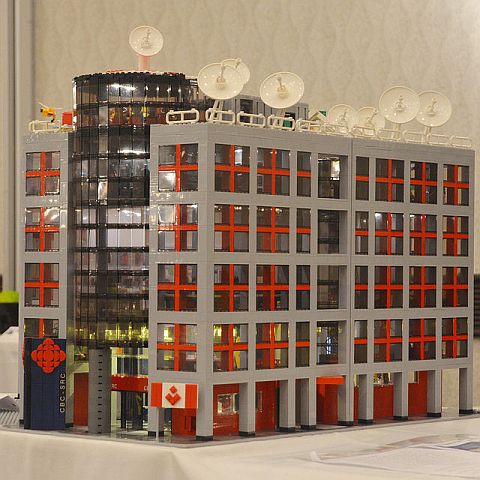
In the meantime, I have also learned about the Canada Builds 150 Project, which is an initiative by LEGO fans Simon Liu from ToroLUG and Adam Dodge from SLUG to recognize Canada’s 150th birthday by highlighting the diversity of the Canadian identity as seen through the eyes of LEGO hobbyists and artists from across the country. Through the project, LEGO fans from across Canada showcase their models based upon moments in Canadian culture and history, architecture, wildlife, and images of national significance. My CBC model seemed to be a perfect match for the project.

To give you an idea about the size of the model, I ordered around 30,000 pieces, which doesn’t account for the pieces I already had in my collection, so yes, it is big. The missing parts came from LEGO’s Pick-A-Brick section and from other LEGO fans via BrickLink. It took 49 BrickLink orders from 45 different stores in 11 countries to get all the parts!
The only non-LEGO elements are lighting components from BrickStuff.com, and the “big screen TV”, which is actually a disguised cell phone. Some slightly modified LEGO pieces are the CBC/SRC custom engraved bricks, and the girders that support the atrium were custom chromed by fellow LEGO enthusiasts. The display also includes 150 minifigs to match Canada’s birthday, including all skin-colors and age-groups, a couple of wheelchair users, and two costumed characters.
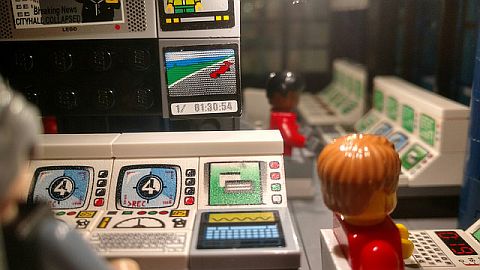
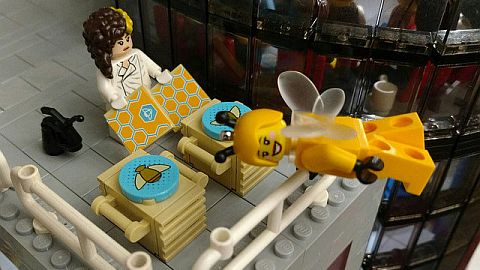
So how much all of that cost, you might ask. I don’t know, and I don’t want to know. Probably more than I should have spent, especially since I bought everything at retail prices. This project is a labor of love, and I’m grateful that I was able to build it.
I think what people liked about the model is that it doesn’t just faithfully recreate the external features of the real building, but it also includes things like working lights and a big screen TV. And it has a lot of fun activities going on the inside as well. I have included some pictures here, and feel free to visit my flickr album for more.
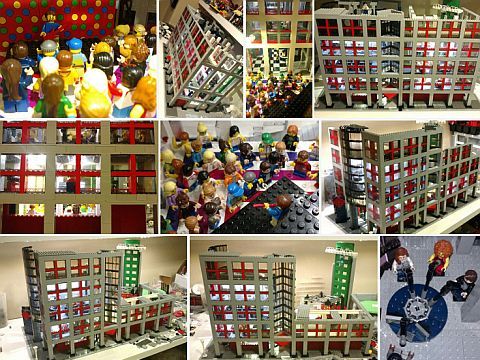
Even though this is not an official CBC project, the model was so popular that it will be on display in the CBC atrium on July 19th and 20th for CBC Kids Days. After that, it will probably be moved to a semi-permanent display close to the CBC Museum. It’s definitely better to have people enjoy the model, rather than having it sit in my basement. Below are some fun facts about some hidden features of the model:
- Can you spot the CBC Radio producer going bananas in his Halloween costume?
- Someone is trying to microwave something forbidden by our office policy. What is it?
- We do have beehives on the roof. Once a year employees can buy tasty CBC honey.
- The round room next to the hive is the Artist Lounge. A former figure skater is giving a talk.
- We used to have paper airplane competitions in the atrium. Some employees miss them.
- We use lots of sticky notes on whiteboards. Can you find some in a boardroom?
- There is a zombie product manager wandering around. If you see him, run!
- Speaking of running, did you see Rasputin, the mail robot, chasing a scared coop student?
- We call that block of elevators in the Atrium “The Green Monster”, but don’t be afraid of it.
- The host in the TV studio is Peter Mansbrick. Thankfully, LEGO celebrities never retire.
- Speaking of celebrities, did you see Matt Leggoway, radio host of Bricksburg Morning?
- How about Brick Mercer catching some sun while waiting for the opening of his show?
- The room with all the screens is not a Spaceship, Spaceship, SPACESHIP! It’s the Master Control.
- There is a LEGO model of the CBC building in this LEGO model of the CBC building.
- While you are at the CBC Museum, say “Hi!” to Mini Dressup and the Friendly Minigiant.
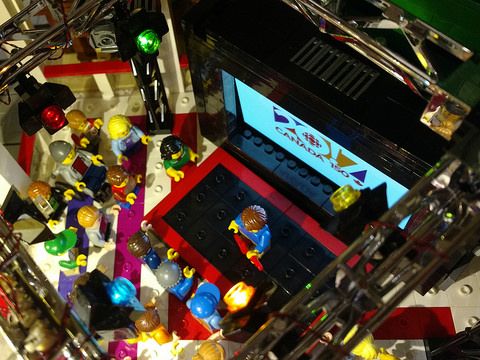
And here are some factual facts about the LEGO CBC model:
- The outside of the LEGO model has the same number of windows as the corresponding section of the real building, where each window “pane” corresponds to an entire floor.
- The real Toronto Broadcasting Center is 13 stories tall, including three underground levels, and totals 1.72 million square feet. The atrium is only 5% of that area.
- The CBC building was built from 1988 to 1992 at a cost of $ 350 million to replace 20 individual facilities that were scattered around the city.
- The pillars have black footings to represent the 3,000 rubber pads that protect the sensitive studio equipment from vibration caused by nearby train tracks.
- The real building houses 3 radio studios, 19 radio production studios, 3 television studios, 2 local television studios, 2 all-purpose studios and 1 national news studio.
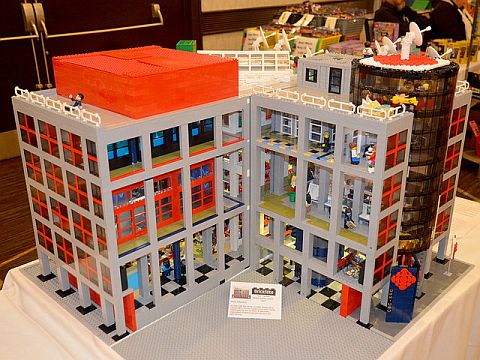
I hope you had a good time reading about this project, and maybe learned a thing or two about this interesting building. If you are in Toronto, you are welcome stop by to see it on display. And if you have any questions or comments, feel free to share them in the comment section below! 😉












Nice job! Very nice build even though I’m not Canadian and you did a terrific job writing it all up etc.
Wow! Awesome job! Thanks for sharing! So many great details both inside and outside. And it’s great that you actually work there!
This is really inspiring. I might do something like this too. Making your home, or place of work, or favorite building out of Lego could be a very fun project. Nicely done!
I wonder whether my Lego interpretation, or my real home, would be the messiest…
LOL! 😀